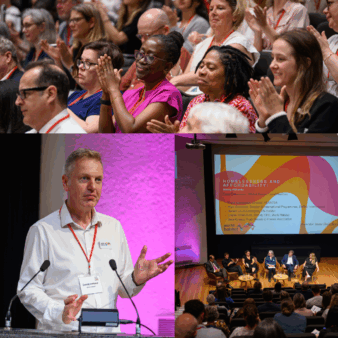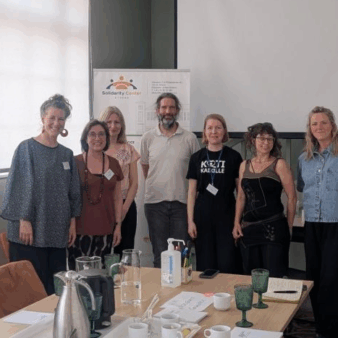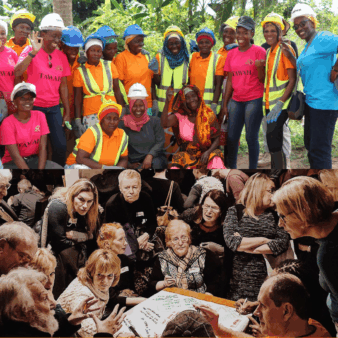
Ahead of a special event at COP26 Samra Siraj – a Manager at the Aga Khan Agency for Habitat (AKAH) in Pakistan – discusses what life is like for remote communities who live on the frontline of the climate emergency, the challenges AKAH are working to overcome and how, through empowering local people, there is hope.
Nestled in some of the world’s highest mountain ranges (the Himalayas, Hindukush, and Karakoram), the northern areas of Pakistan and their bewitching topography showcase many marvels of nature, and yet these areas are on the fringe of policy and development, and poverty is pervasive.
Most of the population lacks adequate access to essential services and is grappling with acute challenges including inaccessibility of area, high unemployment and limited education and health infrastructure. Women and children carry bucket-loads of water on their backs from open and contaminated water channels, while others navigate sketchy roads and harsh terrains to collect logs for warmth during harsh winters. Houses, which should provide safety and security, instead have shaky foundations and sagging ceilings.
Geography compounds the many challenges these community face, as they stand on the front-lines of the climate emergency. The frequency and intensity of environmental disasters has visibly increased in recent decades, further threatening the lives, assets, and livelihoods of these indigenous communities. In short, the place that serves as a heavenly habitat for curious tourists, often fails to provide a safe and comfortable home to its residents, living at the cross-roads of the climate crisis.
Still there are signs of hope amidst these mounting risks and obstacles as different stakeholders are coming together to confront these challenges. Through our – the Aga Khan Agency for Habitat (AKAH) – concerted efforts, the mountains seem to be moving!
The multi-lateral make-up of our organisation allows us to implement a host of innovative solutions for creating resilient habitats and communities. We are a fusion of several established Aga Khan Development Network (AKDN) agencies and programs, including FOCUS Humanitarian Assistance, the Aga Khan Planning and Building Services, and the Disaster Risk Management Initiative.
We help empower dynamic communities by working with them to devise innovative and community-driven solutions that ensure they don’t just survive – but thrive. Our habitat work improves the indoor and built-environment, structural resilience, access to safe water and sanitation services, and connectivity infrastructure.
Our underlying objective to empower the communities in this isolated part of the world is a challenge in and of itself. The remoteness of these far-flung areas poses acute difficulties in disaster response and leads to what would have been preventable deaths.
Climate disasters usually cut off land route-access to impacted areas, hamper already sketchy power, and damage telecommunication facilities. This obstructs the timely delivery of external aid to affected communities and the provision of response and relief-related services. For instance, following the 2005 Kashmir earthquake, entire towns were buried by landslides, which disrupted critical infrastructure and severely impeded aid provision. Thus, it is indispensable to prepare these communities and enhance their resilience in the face of growing disaster risks.
We are fostering an integrated and systematic approach for enhancing the resilience against mounting disaster risks and vulnerabilities, ranging from preparedness and adaptation to response and rehabilitation of impacted communities.
At the heart of this distinctive approach is the tool of Hazard Vulnerability and Risk Assessments (HVRAs), which integrate scientific approaches with local indigenous knowledge, in a participatory manner, to identify and analyze context-specific risks and vulnerabilities. These HVRAs have been indispensable for channeling local knowledge into careful planning, while also advancing diverse disaster and habitat-related humanitarian and development work. The evidence-driven approach has been recognised as a best practice by World Habitat, winning a 2020 Gold World Habitat Award.
Using HVRAs, we have implemented a spectrum of people-led solutions. Our soft measures include creating and strengthening gender-inclusive local response teams to voluntarily respond to disasters; forming the Village Disaster Risk Management Committees (VDRMCs) of key stakeholders who collaborate to analyse community risks, vulnerabilities, and capacities and put together the Village Disaster Risk Management Plans (VDRMPs). VDRMPs act as guiding tools to aid impacted communities following the onset of disasters.
Our hard measures include the establishment of Early Warning Systems (EWS), Weather Monitoring Posts (WMPs), safe heavens, emergency shelters, and emergency stockpiles; the design and implementation of structural mitigation and eco-DRR measures; and the recommendation of appropriate housing solutions. This all-encompassing approach is gathering momentum and empowering the communities facing the brunt of the climate emergency.
A cross-cutting theme of these integrated interventions is the mainstreaming and empowerment of women, as we help amplify their voices in disaster risk reduction work; a field where they have largely been pushed to the margins. Their work with us is playing an exemplary role in altering the conventionally-held perspective that women are merely vulnerable victims of disasters and emergencies. Instead, they are empowered individuals who can actively respond to emergency situations and serve their communities.
We are a staunch believer of continuously improving our approach and expanding our scope to better the lives of remote communities. In line with our rich legacy, HVRAs help move us towards comprehensive habitat and spatial planning; the first of its kind in the disaster-prone areas of Pakistan. Our co-ordinated efforts present a silver lining, as people can be better prepared to face daunting climate crises, so long as they are united behind a joint cause with the right tools and dedication.
You can find out more about the remarkable work of the Aga Khan Agency for Habitat – and how they have integrated indigenous knowledge with the latest technology – at our joint event at COP26 on Monday 8 November.
A future blog from the Aga Khan Agency for Habitat will highlight the stories of community members and of how these interventions are positively impacting their lives.
Image: Arman




Join the discussion